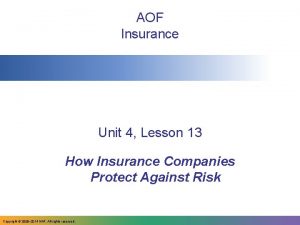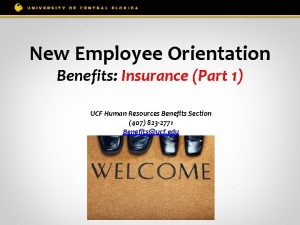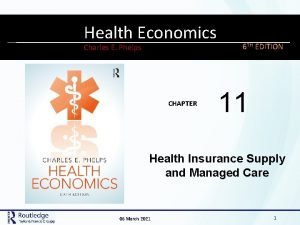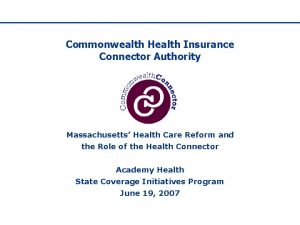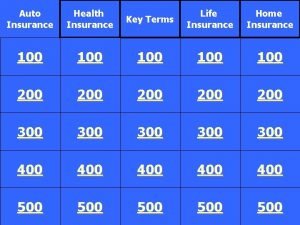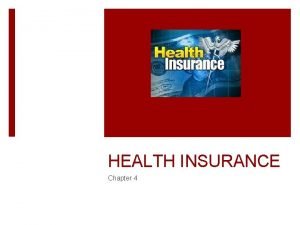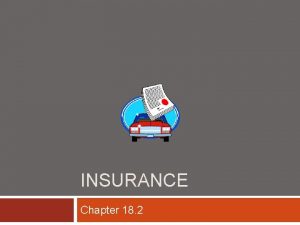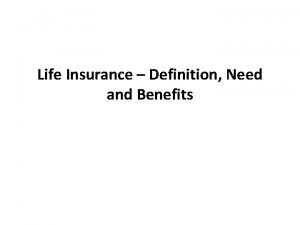Chapter 35 Life and Health Insurance Life Insurance





















- Slides: 21

Chapter 35 Life and Health Insurance

Life Insurance Protects the standard of living of the survivors At the policy holder’s death, the insurance company pays survivors the face value of a life insurance policy Proceeds: the money paid to survivors Beneficiary: each person who receives part of the proceeds Buyer of policy names beneficiaries

Life Insurance: Cash-Value Insurance Cash-value insurance: provides both savings and death benefits ◦ Part of premium pays for death benefits ◦ The rest builds up cash value like a savings account Cash value increases over life of policy Cancel policy, claim collected cash-value Emergency – borrow part or all of cash value Different kinds of cash value insurance

Cash-Value Insurance: Whole Life Insurance A policyholder pays a premium that stays the same throughout his/her lifetime As long as premiums are paid, policy stays the same until death of the insurer Provides savings during the policyholder’s life and pays benefits after death

Cash-Value Insurance: Limited. Payment Life Insurance Pay premiums for certain number of years ◦ EX. 20 -payment life policy, you pay premiums for 20 years “paid up at age 65” Since many retire at 65, they won’t have to pay premiums after paychecks stop

Cash-Value Insurance: Variable Life Insurance Cash value part of premium is invested ◦ Stocks, bonds, and mutual funds rather than savings Rest of premium is used for death benefits Increases or decreases depending on value of investments ◦ EX. Part of premium is used to invest in stock and the stock double in value, the cash value will be worth double

Cash-Value Insurance: Endowment Insurance Special type of cash-value Based more on savings over death benefits Provides coverage for specific period of time ◦ Usually 20 -30 years Proceeds go to policyholder if he/she is still alive If policyholder dies during endowment period, beneficiaries receive proceeds Usually used to provide income for retirement or education ◦ EX. Parents could buy an 18 year, $15, 000 endowment when a child is born

Life Insurance: Term Insurance: life insurance that covers a person for a specific period of time ◦ Could be 5, 10, or 20 years Only pays benefits if person dies within the term If the insurer lives longer, policy has no value Can be renewed…. higher premium “pure protection” – only pays death benefits and no cash value Low cost

Term Insurance continued � How it works: � Your friend purchases a 5 year, $10, 000 policy (covers him for 5 years) � If your friend dies within those first five years, his/her beneficiary will receive $10, 000. � After five years his/her coverage ends � The policy can be renewed over time but with a higher premium � Term insurance is often used as a part of group life insurance � Employers & organizations = employees & members � If you leave company, you lose coverage � Group policies are cheaper than individual policies

Costs of Life Insurance Term insurance costs less than cash value insurance Several factors effect cost of your premium: Age, health, occupation Many people have to take a physical before taking out a policy Older = higher cost Dangerous occupations = higher cost

Health Insurance Protects against the cost of illness and accidents Average cost of one hospital day stay = $5, 000 Most people cannot pay Medical costs = very high

Health Insurance: Major Medical Insurance � *catastrophe insurance � Most important coverage for a serious illness or accident � Covers: hospital care, doctor’s bills, tests and x-rays, and nursing care � Deductible � Some plans may have coinsurance: a percentage of medical expenses a policyholder must pay beyond the deductible � Insurance usually pays 75 -80% of costs and policyholder pays 20 -25% � EX. $1, 000 deductible an coinsurance of 20%. Bills are $6, 000, you pay $2, 000 ($1, 000 deductible and 20 % of $5, 000)

Hospital Expense Insurance Pays for hospital care for a given period of time Covers: room and board, tests and x-rays, operating room costs, nursing care, and fees for drugs and treatments Could have deductible Some policies have limits for specific expenses Some set a max per day for max number of days Most popular type of health insurance

Surgical Expense Insurance Pays part of a surgeons entire fee for operation Max payment for particular surgical expense Policy lists surgeries and costs allowed Major Medical Insurance picks up where Surgical Expense does not cover Usually bought with Hospital Expense Higher maximums for each surgery = higher premium

Medical Expense Insurance Covers the costs of a doctor’s care not involving surgery Could cover visits to doctor’s office or doctor’s calls at hospital Usually purchased with Hospital Expense and Surgical Expense Insurance company could combine all three types into one basic health insurance plan

Group Health Insurance Least expensive form for most people Company or organization provides it for employees or members Employees and members can add extra coverage at their own expense Health maintenance organization (HMO): provides health care at its own health center for a fixed fee per month HMO- you must go to its own clinic and choose one of their doctors HMO plans stress preventive health care to keep medical costs down

Government Health Insurance: Medicare Medicare: a major health insurance program set up by the federal government Provides hospital insurance that covers hospital care Provides medical insurance that covers doctor’s fees and tests For Medicare: ◦ Pay a deductible ◦ Coinsurance ◦ Monthly premium For Hospital Insurance: ◦ Pay deductible

Government Health Insurance: Medicaid Medicaid: another government health care plan for certain groups of citizens Provides care for those who are unable to pay for insurance or health care Much more comprehensive coverage than medicare

Costs of Health Insurance Coinsurance Clause – requires you to pay a certain percentage of medical expenses beyond the deductible Copayment: a fee paid each time a service is used More people covered by a policy = higher premium Many policies won’t cover a pre-existing condition: a serious health condition diagnosed before a person obtained health insurance EX. Someone suffers from a heart condition, an insurance company might refuse to cover it

Understanding the Affordable Care Act The act provides comprehensive health insurance reforms that hold insurance companies more accountable Lower costs More choices Enhance the quality of healthcare

Affordable Care Act � Lower Costs ◦ New creation of a competitive private health insurance market ◦ Stabilizes economy ◦ Expected to reduce deficit over next ten years by $100 billion � End insurance company denial and abuse of care (Americans with pre-existing conditions) � Will continue through 2014 � Covers: ◦ ◦ Individuals Families Seniors Businesses � Reduced premiums for families and small businesses
 Chapter 14 health disability and life insurance
Chapter 14 health disability and life insurance Chapter 3 health wellness and health disparities
Chapter 3 health wellness and health disparities Chapter 1 understanding health and wellness lesson 2
Chapter 1 understanding health and wellness lesson 2 Understanding health and wellness chapter 1
Understanding health and wellness chapter 1 Elements of fire insurance contract
Elements of fire insurance contract Chapter 10 financial planning with life insurance
Chapter 10 financial planning with life insurance Unit 2 lesson 3 health insurance and financial planning
Unit 2 lesson 3 health insurance and financial planning Economics unit 2 lesson 7
Economics unit 2 lesson 7 Health and social component 3
Health and social component 3 Climbs life and general insurance cooperative
Climbs life and general insurance cooperative Texas tech sakai
Texas tech sakai Fau health insurance
Fau health insurance Umms benefits
Umms benefits Tonik blue cross
Tonik blue cross Ouhsc pa program
Ouhsc pa program Raksha tpa claim intimation
Raksha tpa claim intimation Ucf dental insurance
Ucf dental insurance Health insurance market segmentation
Health insurance market segmentation Deloitte health insurance
Deloitte health insurance What is deductible in health insurance
What is deductible in health insurance Health insurance premium payment program ny
Health insurance premium payment program ny Commonwealth connector
Commonwealth connector






